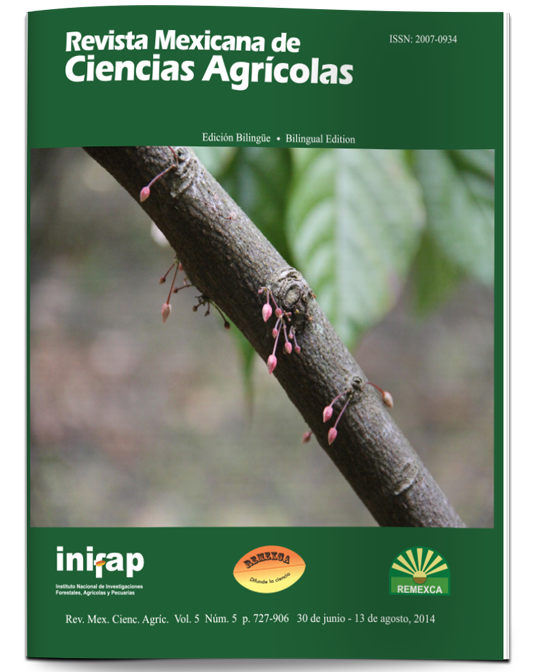Germination and seedling growth of Phaseolus vulgaris L. in saline conditions
DOI:
https://doi.org/10.29312/remexca.v5i5.898Keywords:
sodium chloride, Negro, Pinto and Azufrado beansAbstract
Beans are sensitive to salinity. In Mexico in the autumn-winter cycle, bean production is performed under conditions of residual moisture. Under these conditions, salinity problems are increased and are ref lected in the reduction in the percentage of germination, growth and underground and aerial performance. The levels of damage are different between varieties. In this research, conducted in Nayarit in 2012 in a greenhouse at a temperature of 28.1 oC, the physiological response to salinity induced with sodium chloride, three bean varieties of higher production in Nayarit in the germination stage and seedling was evaluated. The experimental design was completely randomized using three replicates per treatment. Pinto bean germination decreased 54.7% to 9 dS m-1 and beans Azufrado 30.3%. In seedlings, the stem length difference between the control (T0) and the highest treatment (T6) was 2.4, 4 and 3.2 cm for the Negro, Pinto and Azufrado respectively beans. The difference in root length between T0 and T6, was 13.1, 13.4 and 12.1cmfortheNegro,PintoandAzufradorespectivelybeans. It as the electrical conductivity increased germination rate decreased. The Azufrado beans were the toughest and the most affected Pinto. The stem length, fresh weight and dry weight of seedling decreased and increased stem diameter. The length, fresh weight and dry root weight decreased gradually.
Downloads
Downloads
Published
How to Cite
Issue
Section
License
The authors who publish in Revista Mexicana de Ciencias Agrícolas accept the following conditions:
In accordance with copyright laws, Revista Mexicana de Ciencias Agrícolas recognizes and respects the authors’ moral right and ownership of property rights which will be transferred to the journal for dissemination in open access. Invariably, all the authors have to sign a letter of transfer of property rights and of originality of the article to Instituto Nacional de Investigaciones Forestales, Agrícolas y Pecuarias (INIFAP) [National Institute of Forestry, Agricultural and Livestock Research]. The author(s) must pay a fee for the reception of articles before proceeding to editorial review.
All the texts published by Revista Mexicana de Ciencias Agrícolas —with no exception— are distributed under a Creative Commons License Attribution-NonCommercial 4.0 International (CC BY-NC 4.0), which allows third parties to use the publication as long as the work’s authorship and its first publication in this journal are mentioned.
The author(s) can enter into independent and additional contractual agreements for the nonexclusive distribution of the version of the article published in Revista Mexicana de Ciencias Agrícolas (for example include it into an institutional repository or publish it in a book) as long as it is clearly and explicitly indicated that the work was published for the first time in Revista Mexicana de Ciencias Agrícolas.
For all the above, the authors shall send the Letter-transfer of Property Rights for the first publication duly filled in and signed by the author(s). This form must be sent as a PDF file to: revista_atm@yahoo.com.mx; cienciasagricola@inifap.gob.mx; remexca2017@gmail.
This work is licensed under a Creative Commons Attribution-Noncommercial 4.0 International license.



